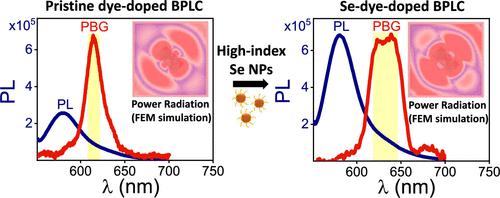当前位置:
X-MOL 学术
›
Chem. Mater.
›
论文详情
Our official English website, www.x-mol.net, welcomes your feedback! (Note: you will need to create a separate account there.)
Effect of High-Index Nanoparticles on the Emission Properties of a Dye-Doped Blue Phase Liquid Crystal
Chemistry of Materials ( IF 8.6 ) Pub Date : 2024-04-17 , DOI: 10.1021/acs.chemmater.4c00471 Nurjahan Khatun 1, 2 , Geetha G. Nair 1
Chemistry of Materials ( IF 8.6 ) Pub Date : 2024-04-17 , DOI: 10.1021/acs.chemmater.4c00471 Nurjahan Khatun 1, 2 , Geetha G. Nair 1
Affiliation

|
This study demonstrates a significant advancement in enhancing photoluminescence (PL) intensity by the inclusion of high-index dielectric nanoparticles into a dye-doped blue phase liquid crystal (BPLC). The blue phase I (BPI), the cubic subphase of the blue phase exhibited by highly chiral liquid crystals, is inherently an incomplete photonic band gap (PBG) system due to the low refractive index contrast Δn (<0.1). The Δn is given by the difference between the refractive indices corresponding to the double twisted cylinders and disclination lines that constitute the blue phases. Being an incomplete PBG system, BPI exhibits a narrow PBG width (2 to 3%), affecting the extent of enhancement in PL intensity in the dye-doped BPLC. An elegant pathway of confining high-refractive index selenium nanoparticles (n = 3.07 at optical frequencies) inside the core of disclination lines effectively increases the Δn (1.4) and thus the PBG width (6%), driving BPI toward a complete PBG. This, in turn, enhances the PL intensity by a factor of 3 when compared to the pristine BPLC, as demonstrated by finite element method simulations and reflection spectroscopy experiments. The simulations reveal that the efficient confinement of electromagnetic waves by the high-index nanoparticles leads to increased density of states (DOS) at the band edges, and hence, the enhanced emission. However, the emission gets suppressed at PBG as the DOS is nearly zero at the band gap. The in situ modulation in PL intensity is experimentally established utilizing thermally induced PBG tunability. Simulations also suggest that the enhancement in PL intensity strongly depends on the orientation and position of the dipole (dye) within the photonic cavity. Thus, incorporating high-index nanoparticles in the dye-doped BPLC enhances PL intensity, rendering the system more conducive for various optoelectronic applications such as light-emitting diodes and light-emissive displays.
中文翻译:

高折射率纳米粒子对染料掺杂蓝相液晶发射性能的影响
这项研究表明,通过将高折射率介电纳米颗粒纳入染料掺杂的蓝相液晶 (BPLC) 中,在增强光致发光 (PL) 强度方面取得了重大进展。蓝相 I (BPI) 是高手性液晶表现出的蓝相立方亚相,由于折射率对比度 Δ n (<0.1) 较低,本质上是不完全光子带隙 (PBG) 系统。 Δn由对应于构成蓝相的双扭转圆柱体和向错线的折射率之间的差给出。作为一个不完整的 PBG 系统,BPI 表现出较窄的 PBG 宽度(2% 至 3%),影响了染料掺杂 BPLC 中 PL 强度的增强程度。将高折射率硒纳米颗粒(光频率下n = 3.07)限制在向错线核心内的优雅路径有效地增加了 Δ n (1.4),从而增加了 PBG 宽度 (6%),推动 BPI 走向完整的 PBG。有限元方法模拟和反射光谱实验证明,与原始 BPLC 相比,这反过来又将 PL 强度增强了 3 倍。模拟结果表明,高折射率纳米颗粒对电磁波的有效限制导致能带边缘的态密度(DOS)增加,从而增强了发射。然而,由于带隙处的 DOS 几乎为零,因此 PBG 处的发射受到抑制。 PL 强度的原位调制是利用热诱导 PBG 可调谐性通过实验建立的。模拟还表明,PL 强度的增强很大程度上取决于光子腔内偶极子(染料)的方向和位置。因此,在染料掺杂的 BPLC 中加入高折射率纳米粒子可以增强 PL 强度,使系统更有利于各种光电应用,例如发光二极管和发光显示器。
更新日期:2024-04-18
中文翻译:

高折射率纳米粒子对染料掺杂蓝相液晶发射性能的影响
这项研究表明,通过将高折射率介电纳米颗粒纳入染料掺杂的蓝相液晶 (BPLC) 中,在增强光致发光 (PL) 强度方面取得了重大进展。蓝相 I (BPI) 是高手性液晶表现出的蓝相立方亚相,由于折射率对比度 Δ n (<0.1) 较低,本质上是不完全光子带隙 (PBG) 系统。 Δn由对应于构成蓝相的双扭转圆柱体和向错线的折射率之间的差给出。作为一个不完整的 PBG 系统,BPI 表现出较窄的 PBG 宽度(2% 至 3%),影响了染料掺杂 BPLC 中 PL 强度的增强程度。将高折射率硒纳米颗粒(光频率下n = 3.07)限制在向错线核心内的优雅路径有效地增加了 Δ n (1.4),从而增加了 PBG 宽度 (6%),推动 BPI 走向完整的 PBG。有限元方法模拟和反射光谱实验证明,与原始 BPLC 相比,这反过来又将 PL 强度增强了 3 倍。模拟结果表明,高折射率纳米颗粒对电磁波的有效限制导致能带边缘的态密度(DOS)增加,从而增强了发射。然而,由于带隙处的 DOS 几乎为零,因此 PBG 处的发射受到抑制。 PL 强度的原位调制是利用热诱导 PBG 可调谐性通过实验建立的。模拟还表明,PL 强度的增强很大程度上取决于光子腔内偶极子(染料)的方向和位置。因此,在染料掺杂的 BPLC 中加入高折射率纳米粒子可以增强 PL 强度,使系统更有利于各种光电应用,例如发光二极管和发光显示器。



























 京公网安备 11010802027423号
京公网安备 11010802027423号